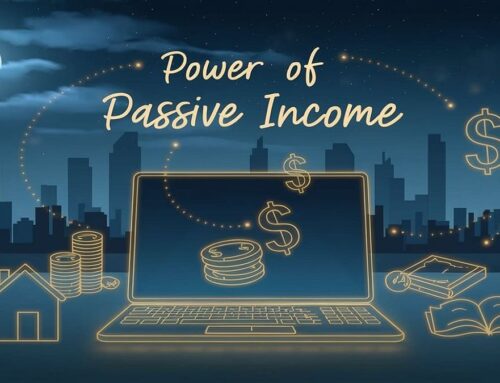
Guide to Passive Income
Picture this: You’re sitting on a beach, sipping your favorite drink, while your bank account grows in the background. No boss to answer to, no alarm clock to wake you up and no endless to-do lists hanging over your head. Does that sound like a dream? For many, it’s the ultimate goal – Financial Independence. But how do you get there?
The answer lies in Passive Income.
Passive income is the money you earn without actively working for it every day. It’s the key to breaking free from the 9-to-5 grind and living life on your own terms. But here’s the catch – building a reliable stream of passive income requires effort, strategy and patience. You won’t get rich overnight, but with the right approach, you can create a system that pays you for years to come.
Ready to learn how? Let’s dive into the ultimate guide to achieving financial independence through passive income.
What Exactly Is Passive Income?
Before we jump into the strategies, let’s clarify what passive income really is. At its core, passive income refers to the money that keeps coming in even when you’re not directly working for it. Unlike active income (your job, where you trade time for money), passive income works on its own, after you’ve set up the systems.
Think of it as planting a seed. At first, you have to water it and give it sunlight. But once it grows, it begins to bear fruit season after season, with minimal effort on your part.
So, what are some common examples of passive income?
- Rental properties: Owning property that generates rent.
- Dividend stocks: Investing in stocks that pay regular dividends.
- Online businesses: Websites or apps that generate revenue on autopilot.
- Affiliate marketing: Earning commissions by promoting other people’s products.
- Royalties: Getting paid for content you’ve created, like books, music or patents.
The possibilities are vast. Now, let’s break down how you can start building passive income streams.
-
Build a Foundation First
Here’s the truth: Passive income doesn’t just fall into your lap. It requires Upfront Effort, sometimes a lot of it. And before you can even begin generating passive income, you need to have a solid financial foundation.
- Pay off high-interest debt: If you have credit card debt or high-interest loans, prioritize paying them off. The interest you’re paying on these debts could be far higher than any passive income return you’d earn.
- Save an emergency fund: Having 3 to 6 months’ worth of expenses saved up gives you a safety net. You’ll feel more comfortable taking risks and making investments when you know you’re financially secure.
- Automate your savings: If you don’t already have automatic contributions going into a retirement or investment account, set that up. Automation is a form of passive savings, money grows while you sleep.
Once you’ve handled the basics, you’re ready to start exploring ways to create passive income streams. But here’s the question: Which method should you choose?
-
Real Estate: Building Wealth Brick by Brick
One of the most popular and historically reliable methods of generating passive income is Real Estate Investing. Why? Because people always need a place to live. When you own property, you can collect rent from tenants month after month, building equity in an asset that generally appreciates over time.
Here’s how to get started:
- Buy rental property: This is the classic route. Purchase a single-family home, apartment or multi-unit building and rent it out. Just keep in mind that being a landlord isn’t completely passive – there’s maintenance, tenant communication and repairs. But if you hire a property management company, you can take a step back and let them handle the day-to-day.
- Real estate investment trusts (REITs): Don’t want the hassle of owning physical property? REITs allow you to invest in real estate without getting involved in the operations. You buy shares in a company that owns and manages properties and in return, you get a cut of the profits.
- Short-term rentals: Think Airbnb or vacation rentals. While this can be more hands-on than long-term rental properties, the income potential is often higher. The key is finding the right location.
Does real estate sound appealing? Or maybe it’s too hands-on for you. That’s okay, let’s look at another option that’s completely virtual.
-
Dividend Investing: Let Your Money Work for You
What if you could get paid just for owning a piece of a company? That’s exactly what Dividend Stocks allow you to do. Dividends are a portion of a company’s earnings paid out to shareholders, usually on a quarterly basis. If you invest in dividend-paying stocks, you can earn a steady stream of income without lifting a finger.
But here’s the key: Not all stocks pay dividends and not all dividends are created equal.
- Look for dividend aristocrats: These are companies that have consistently increased their dividend payouts for 25 years or more. They’re usually stable, established companies like Coca-Cola, Procter & Gamble and Johnson & Johnson.
- Reinvest your dividends: When you’re just starting, reinvesting dividends rather than cashing them out can accelerate your wealth-building process. Many brokerage firms offer automatic dividend reinvestment plans (DRIPs), allowing you to buy more shares without any effort.
- Diversify your portfolio: Don’t put all your eggs in one basket. Spread your investments across different sectors to reduce risk.
Does investing in stocks sound too complicated? Don’t worry, there are easier ways to make your money work for you.
-
Create Digital Products: Earn While You Sleep
We live in a digital age and the internet has opened up endless possibilities for creating passive income. One of the most scalable ways to generate income online is by creating Digital Products. This could be anything from e-books and online courses to stock photos and design templates.
The beauty of digital products is that you create them once and they can continue to sell for years with minimal ongoing work.
Here’s how you can get started:
- Identify your expertise: What skills or knowledge do you have that others are willing to pay for? Maybe you’re great at photography, web design or personal finance. Turn that expertise into a product.
- Choose your platform: Platforms like Udemy, Skillshare or Teachable allow you to host and sell online courses. Amazon’s Kindle Direct Publishing (KDP) is perfect for self-publishing e-books. Or, if you’re a designer, you can sell templates on marketplaces like Etsy or Creative Market.
- Market your product: Creating the product is just step one. You’ll need to market it, through social media, email marketing and SEO, to get sales rolling in.
The best part? Once your product is live, the bulk of the work is done and you can focus on creating additional streams of passive income.
-
Affiliate Marketing: Get Paid to Recommend Products
Have you ever recommended a product to a friend? Imagine getting paid every time you did that. That’s essentially what Affiliate Marketing is. You promote someone else’s product or service and if someone buys it using your link, you earn a commission.
Affiliate marketing is one of the most accessible forms of passive income because you don’t need to create your own product. Instead, you leverage your platform, whether that’s a blog, YouTube channel or social media account, to promote products you believe in.
To get started:
- Choose a niche: Focus on a specific area of interest, like fitness, personal finance or travel. This will help you build a loyal audience that trusts your recommendations.
- Sign up for affiliate programs: Many companies have affiliate programs. Popular platforms like Amazon Associates, ShareASale and CJ Affiliate connect you with a variety of products to promote.
- Create valuable content: Your goal is to provide value to your audience while subtly promoting products. For example, you could write a blog post reviewing different tech gadgets or create a YouTube tutorial on using a particular software tool.
Affiliate marketing can be a slow burn at first, but once you build up a library of content and grow your audience, it can turn into a steady stream of passive income.
-
Peer-to-Peer Lending: Be the Bank
What if you could act like a bank and lend money to others in exchange for interest payments? Peer-to-Peer Lending allows you to do just that. Platforms like LendingClub and Prosper connect individual lenders (like you) with borrowers who need loans. In return for lending your money, you earn interest.
Of course, with higher returns comes higher risk. Not all borrowers will repay their loans, so you need to be mindful of where you allocate your money.
Here’s how to get started:
- Choose a lending platform: Research peer-to-peer lending platforms to find one that matches your risk tolerance and financial goals. Some platforms allow you to manually choose borrowers, while others offer automated investing.
- Diversify your loans: Just like with stocks, diversification is key to managing risk. Don’t put all your money into a single loan. Spread it across multiple loans to reduce the impact of any defaults.
- Reinvest your earnings: As you start to collect interest payments, reinvest them into new loans to take advantage of compounding returns.
Peer-to-peer lending can be a high-yield form of passive income, but it requires careful planning and diversification to manage the risk.
-
Royalties: Get Paid for Your Creativity
If you’re a creative person, passive income might already be within reach. Royalties are payments you receive for using your intellectual property, whether that’s a book, song, photo or invention. The idea is simple: You create something once and every time someone uses it, you get paid.
Here are a few examples of how you can earn royalties:
- Write a book: Self-publishing platforms like Amazon KDP make it easier than ever to write and sell your own books. Each time someone buys your book, you get a cut of the sale.
- License your music: If you’re a musician, you can license your music for commercials, TV shows or movies. Every time your music is used, you earn royalties.
- Sell stock photos: If you’re a photographer, platforms like Shutterstock or Adobe Stock allow you to sell your photos. Every time someone downloads one of your images, you get paid.
Royalties offer one of the most hands-off forms of passive income, but they require significant upfront work. Creating something people want to buy takes time, talent and effort.
-
Automating Your Income Streams
One of the most exciting aspects of passive income is the ability to automate your income streams. Once you’ve set up your systems, whether that’s through real estate, dividend stocks, online businesses or affiliate marketing, automation tools can take over the repetitive tasks, leaving you with more time to focus on other opportunities or simply enjoy life.
- Use tools like Hootsuite or Buffer to automate social media marketing for your affiliate content or digital products.
- Set up automatic payments for your real estate mortgage and rental income collection.
- Create automatic investment plans for dividend reinvestment or peer-to-peer lending.
Automation reduces your workload and allows your income to scale without requiring more time or effort from you.
Conclusion: The Road to Financial Independence
Passive income is the secret to achieving financial independence and living life on your own terms. But remember, it takes time, effort and strategic thinking to set up these income streams.
So, let me ask you: What’s your first step going to be?
Will you invest in real estate, buy dividend-paying stocks or create a digital product? Whatever path you choose, start small, be patient and keep building. Financial independence isn’t a distant dream, it’s a realistic goal that you can achieve with persistence and the right strategies.
Now, go out there and start building your passive income empire.
6 Comments
Leave A Comment
Categories
- Business Growth Strategies (143)
- Customer Experience and Retention (23)
- Digital Marketing and SEO (29)
- Financial Planning and Investment (25)
- Leadership and Team Management (28)
- Personal Development and Productivity (71)
- Technology and Innovations (53)
- USA Biz Growth (1)
Subscribe To Our Newsletter














great post, very informative. I wonder why the other specialists of this sector don’t notice this. You should continue your writing. I am confident, you have a huge readers’ base already!
Thanks for another informative blog. Where else could I get that kind of information written in such an ideal way? I have a project that I am just now working on, and I have been on the look out for such information.
you have an incredible blog right here!
Very interesting information!Perfect just what I was looking for!
You have remarked very interesting details! ps decent website . “Gratitude is the sign of noble souls.” by Aesop.
I get pleasure from, result in I found exactly what I was taking a look for. You have ended my 4 day lengthy hunt! God Bless you man. Have a nice day. Bye